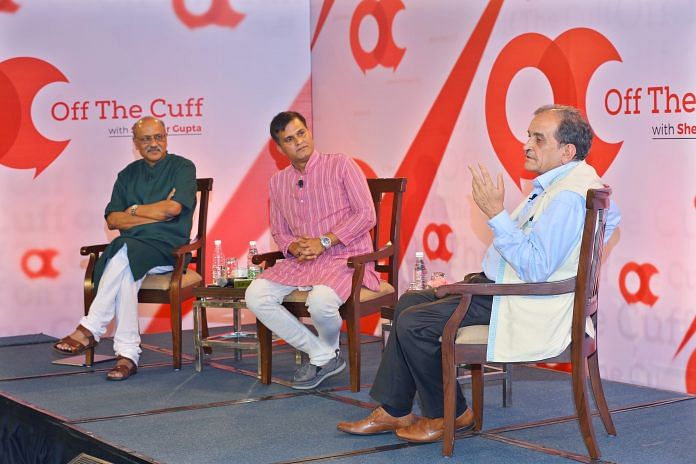The Union steel minister is the first member of the Modi govt to openly disapprove of Sinha’s act of garlanding lynching convicts.
New Delhi: Union steel minister and BJP leader Birender Singh has said there is “no question” of him doing what his ministerial colleague Jayant Sinha did in Jharkhand, a statement that maybe the first open disapproval by someone in the Modi government of Sinha’s act of garlanding lynching convicts earlier this month.
“There is no question of that. See, if they are acquitted then it’s fine. These people were released on bail; you cannot say that they are innocent,” Singh said, when asked if he would have done what Sinha did, at ‘Off The Cuff’ Monday.
Singh, who was in the Congress for four decades before joining the BJP ahead of the 2014 Lok Sabha polls, was in conversation with ThePrint Editor-in-Chief Shekhar Gupta and Associate Editor Kumar Anshuman.
While Sinha’s action had created a huge controversy, the BJP leadership chose to stay silent on the matter, letting the minister defend himself.
Singh said there should be strict laws for lynching.
“Mob lynching is not a new thing. But it should be dealt with very strictly. There should be no laxity on part of the government,” he said.
“Our home minister has formed a high-level committee headed by the home secretary and a group of ministers has already been formed. Within 15 days, we will come out with strict amendments in the IPC,” he added.
‘Third front not a good idea’
At a time when various opposition parties are attempting to form, what is called, a ‘third front’ against the BJP, Singh said regional parties getting over 180 seats in the Lok Sabha wouldn’t be good for the country.
“When I was in the Congress for 40 years, I had seen three such events. Parties opposed to the Congress used to come together and that is happening with the BJP now,” he said.
“It (BJP) is the most powerful party now…People today want a stable mandate and that’s why they gave complete majority to the BJP and Modi. And that’s why I think if regional parties have the strength of 180 or more in Parliament, it’s not good,” he added.
The minister, who belongs to the Jat community that has been agitating for reservations in Haryana, also made a strong and unequivocal case for the need for reservations.
“I would say that India should never be reservation-free because the exploitation, maybe of SC and other communities in this country, is not recent happenings …For centuries, we were being exploited by the upper strata of the society and we deserve all kinds of reservation,” he said.
Difference between Congress & BJP
Making a distinction between the Congress and the BJP, saying while the former is a movement, the latter is a cadre-based party.
“My stay in the Congress was for about 40 years. Very few people have enjoyed this privilege. It requires survival instinct to be there. It is not that easy,” he said.
“There is a difference between the Congress and the BJP. Congress is a movement. If you come, you will be welcomed, if someone with greater credentials comes, he/she will be welcomed more,” Singh said. “BJP is a cadre-based party. The cadre enjoys prominence there.”
Pointing out the importance of leadership in politics, Singh said, “My assessments for the BJP were that in 2014 they would have won about 150-160 seats. However, under Modi, the tally went up to 282.”
“Similarly, the Congress which had won 206 seats in 2009 came down to 44 due to a lack of leadership,” he said.
When asked about Congress president Rahul Gandhi hugging Prime Minister Narendra Modi in Parliament during Friday’s no-confidence motion, Singh joked that Gandhi got so excited thinking he had made a big speech, that he would have hugged anyone, not just the PM.
The minister, who earlier held portfolios like rural development and panchayati raj in this government, also outlined the vision for the steel sector.
‘India to produce 255 mn ton steel in a decade’
“We contribute to approximately 2 per cent of the GDP and we are capital-intensive. In accordance to our steel policy, we are expecting 300 million tonne capacity and 255 million tonne production after 11-12 years,” Singh said.
“What we are thinking is that India should be a destination for the next 50 years. There should not be dearth of consumption,” he said.
According to the steel minister, more than 8 million tonne of scrap is used In India and mostly it is imported.
“The transport ministry came up with a legislation saying that all diesel cars beyond 15 years and petrol cars beyond 20 years will have to be off road. The amount of scrap would be 6.5 million tonne to 7 million tonne, which is almost the requirement of 70-80 per cent of the population,” Singh said.
“This steel can be used after recycling…Now we have a shredding plant that is being developed with Mahindra. It will help us segregate steel and aluminium and other components,” he added.
(With inputs from Avishek Jha and Aastha Singh)




